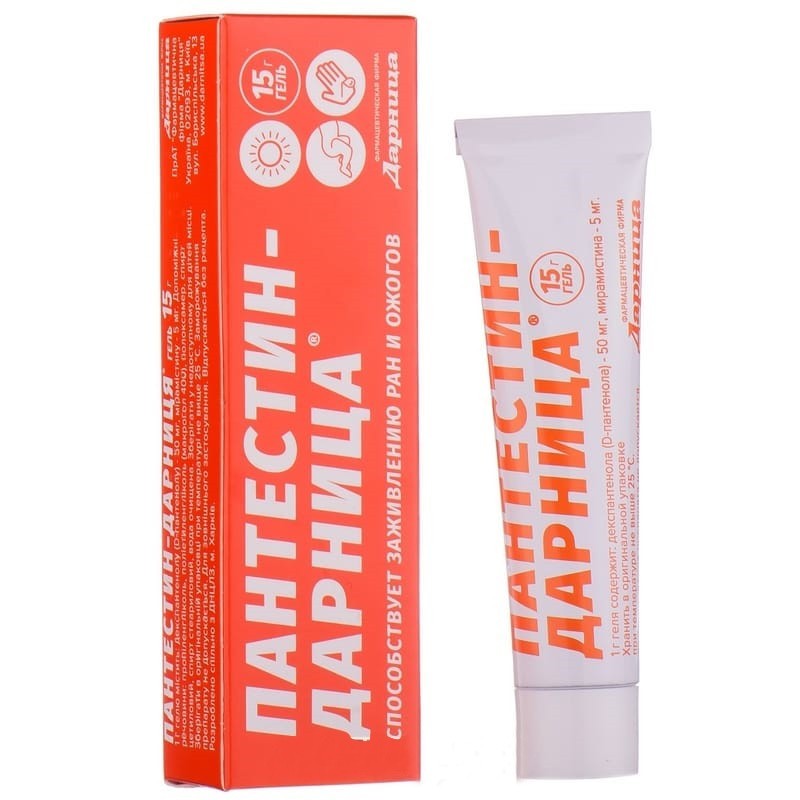



 Secure and encrypted payment processing
Secure and encrypted payment processing We ship to over 40 countries including the USA, UK, Europe, Australia and Japan
We ship to over 40 countries including the USA, UK, Europe, Australia and Japan Guaranteed refund or reship if you haven't received your order
Guaranteed refund or reship if you haven't received your orderPharmacodynamic parameters. Pantestin-Darnitsa gel contains two pharmaceutically active ingredients: dexpanthenol and miramistin.
Dexpanthenol - an indispensable component of a normally functioning epithelium - is a biologically active stable form of pantothenic acid.
Dexpanthenol is easily converted to pantothenic acid, which increases the content of reduced glutathione in the cells (antioxidant effect), promotes ATP synthesis, and is also part of coenzyme A (CoA). CoA and ATP molecules are involved in the synthesis of fatty acids, phospholipids and cholesterol, necessary for the restoration of cell membranes. In addition, CoA is involved in the metabolism of proteins of epithelial cells.
In vitro studies have established the effect of dexpanthenol on human fibroblasts - enhancing their proliferation, migration and adhesion processes, collagen synthesis.
Due to its good penetration through the skin and high local concentrations, dexpanthenol is widely used to stimulate the processes of epithelization, granulation of damaged skin and reduce skin itching.
In addition, dexpanthenol improves barrier properties, hydration of the stratum corneum, reduces transepidermal water loss, maintaining softness and elasticity of the skin, and also has anti-inflammatory properties.
In order to prevent infection of long-term non-healing wounds and treat wound infection, the effect of the drug is supplemented with the antiseptic miramistin.
The surfactant of the cationic type miramistin, due to interaction with the lipids of the outer membrane of the microorganism, has a destructive effect on the causative agents of wound infection. Gram-positive cocci (primarily staphylococci, as well as streptococci, including pneumococci) are highly sensitive to the substance. Miramistin is effective against gram-negative pathogens. Miramistin activity is directed to microorganisms of both aerobic and anaerobic types, non-spore-forming and spore-forming; including microbial associations and hospital microflora with multiple antibiotic resistance (increases the sensitivity of microbes to these drugs). Inhibits the formation and growth of biofilms of Staphylococcus aureus and Streptococcus pyogenes (group A). Miramistin also effectively affects large viruses (including herpes), dermatophytes, ascomycetes, yeast and yeast-like fungi.
Due to the pronounced hyperosmolar effect in the wound and adjacent tissues, the use of miramistin helps to inhibit the inflammation process.
The local effects of miramistin are supplemented by stimulation of the restoration of damaged tissues during its use, including in the case of non-healing wounds.
Pharmacokinetic parameters. When applied topically, dexpanthenol is rapidly absorbed, metabolizing in the tissues to pantothenic acid.
Miramistin is unlikely to enter the systemic circulation, the substance has an effect on microorganisms in the wound area and adjacent tissues.
Locally. distributed in a thin layer on the surface of the wound after its standard processing. after applying a sterile gauze dressing. as an option - apply the gel to the dressing, and then to the wound surface.
In the presence of wound exudate, before applying the gel, the wound is treated with an antiseptic and dried with a sterile napkin.
In case of damage to the skin and sunburn, the drug is applied to the affected areas.
Gynecological pathology: tampons soaked with the drug are administered in a prone position deep in the vagina.
In the treatment of diseases of the oral cavity, the drug is used only in adults. After cleansing the oral cavity, the gel is distributed in a thin layer on the affected area. Do not drink liquid or food for 1 hour. In the treatment of manifestations of prosthetic stomatitis, dentures can be used after applying the gel.
Apply 2-3 times a day for 7-10 days (until complete healing of the affected area or reduce the intensity of inflammation).
Hypersensitivity to the active pharmaceutical ingredients of the drug or its other components.
Protect eyes from gel.
Do not use in case of severe purulent exudation from the wound.
The duration of treatment is determined by the doctor individually.
During pregnancy and lactation, it is possible to use the gel after consulting a doctor (avoid applying to large areas of the skin).
Used in children from the first days of life.
There is no effect on the reaction rate when driving vehicles or other mechanisms.
The antimicrobial effect of miramistin is inactivated:
The combined use of miramistin:
When applied topically, it is unlikely. if the gel is accidentally swallowed, symptomatic treatment is performed.
At a temperature of ≤25 ° C in the original packaging. do not freeze.